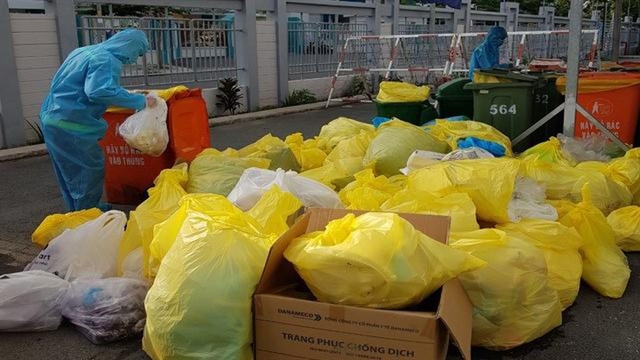 Society
Society


|
| Waste from COVID-19 patients is placed into yellow bags. — Photo phapluatmoitruong.vn |
HÀ NỘI — Home quarantine and treatment for COVID-19 patients in Hà Nội with none or only mild symptoms is considered an effective measure to help relieve pressure for the medical sector but the treatment of waste generated by home-based F0 remains a huge challenge.
In response to the complicated progression of the pandemic, the municipal Department of Natural Resources and Environment and local environmental companies prepared and guided the collection and treatment of waste generated.
The Ministry of Health provided guidelines for home-treatment COVID-19 patients to classify medical waste to prevent infection and environmental pollution.
The Hà Nội People’s Committee earlier this month issued a plan to classify, collect, transport and treat waste from home-based F0 patients in response to increasing number of infections.
The classification of waste is important because such waste could be potentially infected with the virus. If not managed and treated properly, the risk of secondary transmission increases. Normally, infectious waste will be incinerated.
Under the plan, all waste generated by patients treated at home is classified as infectious waste and will be collected into a yellow bag which is tightly tied and then be placed in the second yellow bag, also tightly sealed. The yellow bags must be labelled “Waste potentially infected with SARS-CoV-2”.
After that, the waste will be disinfected and transported by local sanitation workers to points designated to store infectious waste at medical stations of communes, wards or towns or mobile medical stations or temporary storages assigned by local authorities.
However, as the number of F0 and F1 isolated and treated at home keeps increasing, the amount of waste also rises, leading to some problems.
The Environmental Equipment and Materials Joint Stock Company 13 under the Hà Nội Urban Environment Company alone collects around 2-3 tonnes of waste from quarantine areas.
Meanwhile, there are not enough human resources to collect waste from every house having F0 treated at home and waste classification has yet been completely done.
Additionally, many households with patients treated at home do not know about the regulations on waste treatment.
V.T.L, a resident in Hà Nội’s Đống Đa District who has made full recover from COVID-19 after being treated at home, told Pháp luật và Môi trường (Law and Environment) online newspaper that she was not guided how to dispose of waste properly as well as handle personal belongings of a F0 case.
“I was isolated at home alone but was not directed how to treat household waste," she said.
"One of my friends told me to tie the waste collection bag tightly, disinfect the bag and then put in into dustbins.”
Another patient, N.T.T, from Thanh Xuân District, told the newspaper that his family was not guided how to treat daily waste so they still put trash into dust bins as normal.
The Ministry of Health recently asked the People’s Committees of localities to guide measures about medical waste management at COVID-19 treatment areas. Local medical establishments are requested to strictly abide by regulations on classifying, collecting, transporting and treating medical waste, particularly infectious waste.
Localities were also ordered to increase inspection and supervision over medical waste management at medical establishments, COVID-19 treatment facilities and quarantine areas and strictly punish violators.
However, according to many experts, the management, collection and treatment of household waste from COVID-19 patients face many difficulties. Patients treated at home are located at different areas, leading to longer time for sanitation workers to go to collect as well as higher transportation cost. Meanwhile, the number of sanitation workers is limited while they are not fully equipped with protective equipment and disinfecting materials.
Hà Nội continues to record the highest number of infections in the country, at an average of just under 3,000 cases per day.
The country's current largest COVID-19 hotspot now has more than 62,000 active COVID-19 cases, of which over 80 per cent are being treated at home. — VNS